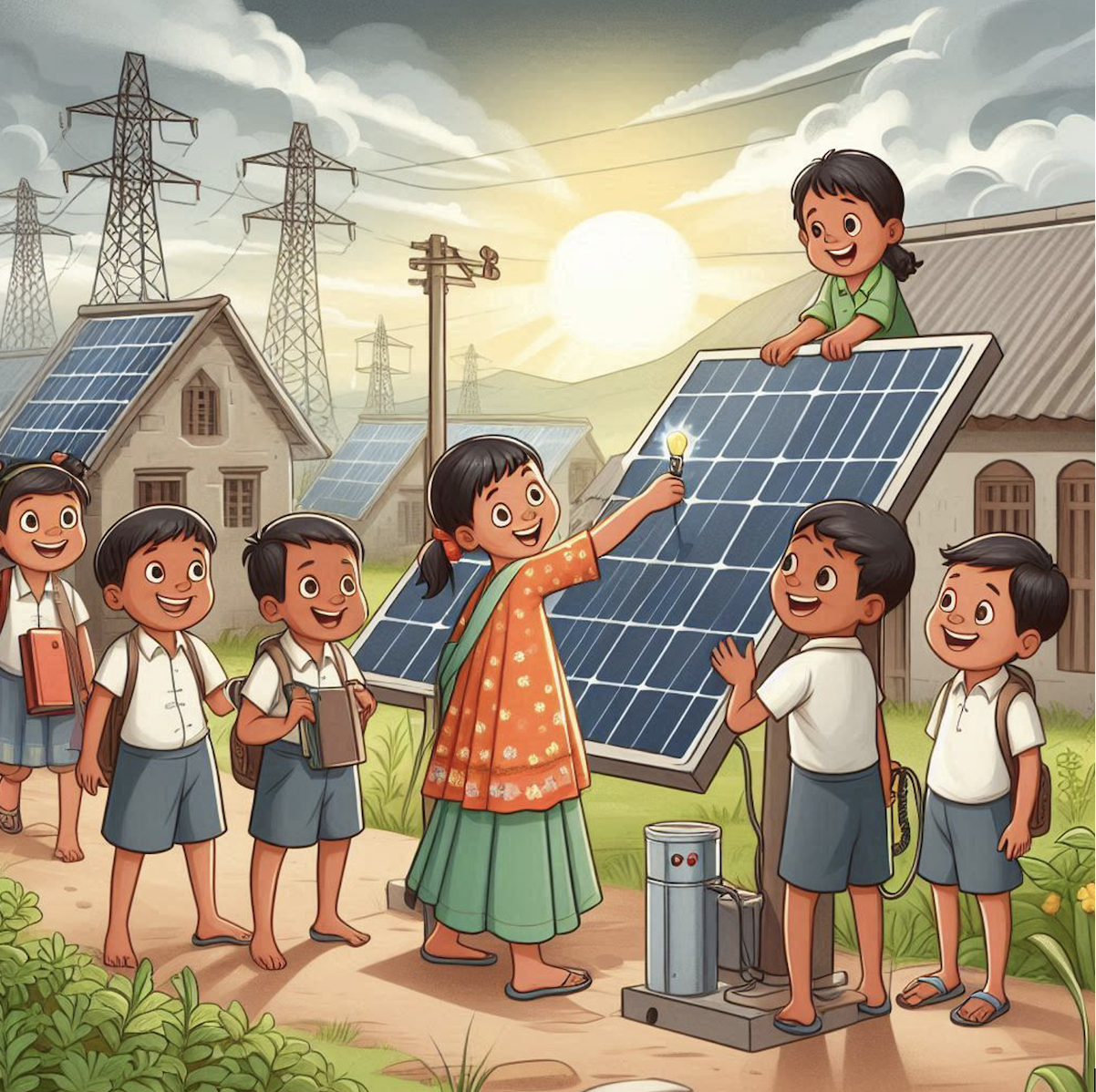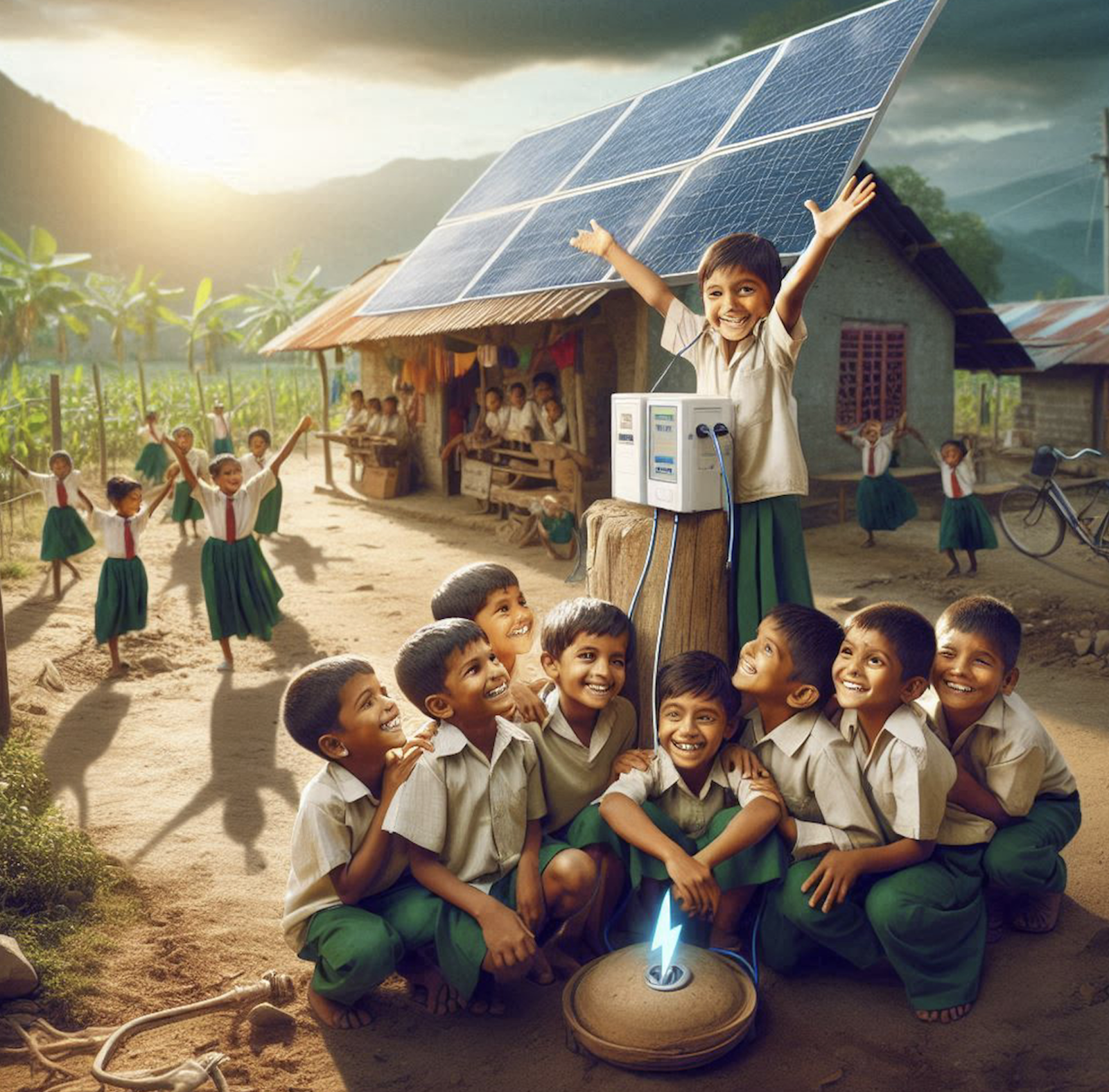
Solar Energy - The Education-Energy Connection in Rural India
Solar Energy: A Clean and Powerful Catalyst for Quality Education in Rural India
In the vast and diverse landscape of India, rural schools often face persistent challenges—one of the most pressing being the lack of reliable electricity. Inadequate power supply disrupts learning environments, hinders the use of modern educational tools, and limits overall school performance. Solar energy, a clean, sustainable, and increasingly affordable solution, has emerged as a game-changer in bridging this energy gap and boosting the quality of education in rural India.
Why Solar Energy?
Solar energy harnesses the abundant power of the sun to generate electricity without emitting greenhouse gases or depleting natural resources. For a country like India, which receives ample sunlight for most of the year, solar power presents a practical, scalable, and cost-effective solution—especially for remote areas where grid connectivity is either weak or non-existent.
The Education-Energy Connection in Rural India
1. Reliable Power for Learning Infrastructure
Many rural schools struggle with frequent power cuts or complete lack of electricity. This hampers basic needs like lighting, fans during hot seasons, and digital learning tools such as projectors, computers, and online content. Solar energy can provide uninterrupted power, ensuring classrooms are well-lit and equipped for modern learning.
2. Digital Education Access
With the National Education Policy (NEP) 2020 promoting digital literacy, access to educational content through computers and smart classes is essential. Solar-powered systems support the use of tablets, internet modems, smart TVs, and e-learning kits, making digital education accessible even in the most isolated areas.
3. Extended Learning Hours
With solar lighting, schools can remain open beyond daylight hours. This is particularly important for remedial classes, evening study sessions, or adult literacy programs, which often take place after sunset.
4. Empowering Teachers and Administrators
A powered school enables teachers to prepare lessons using computers, conduct online training, maintain digital records, and communicate efficiently with education departments and parents. This strengthens the overall management and governance of schools.
5. Promoting Health and Safety
Solar-powered water pumps and purification systems ensure clean drinking water. Fans and lighting improve ventilation and safety in school buildings, particularly in girls’ toilets, leading to increased school attendance, especially among adolescent girls.
Clean Energy, Clean Environment
Solar energy contributes significantly to environmental sustainability. Unlike diesel generators, solar panels emit no pollution, reduce carbon footprints, and promote climate awareness. Schools powered by solar energy become living laboratories where students can learn about renewable energy, environmental responsibility, and sustainable living.
Cost Efficiency and Long-Term Value
Though initial installation costs may seem high, solar systems pay for themselves over time by eliminating monthly electricity bills. Many systems last 20–25 years with minimal maintenance, offering long-term savings. Government subsidies, CSR initiatives, and NGO support further reduce financial barriers for adoption in rural schools.
Real-Life Impact: Stories from the Field
Across states like Rajasthan, Uttar Pradesh, Odisha, and Assam, solar installations have transformed rural schools. For instance, schools equipped with rooftop solar systems have reported:
- Up to 30% improvement in student attendance
- Enhanced teacher retention
- Greater student engagement in science and technology
- A surge in digital learning activities
The Education-Energy Connection in Rural India
1. Reliable Power for Learning Infrastructure
Many rural schools struggle with frequent power cuts or complete lack of electricity. This hampers basic needs like lighting, fans during hot seasons, and digital learning tools such as projectors, computers, and online content. Solar energy can provide uninterrupted power, ensuring classrooms are well-lit and equipped for modern learning.
2. Digital Education Access
With the National Education Policy (NEP) 2020 promoting digital literacy, access to educational content through computers and smart classes is essential. Solar-powered systems support the use of tablets, internet modems, smart TVs, and e-learning kits, making digital education accessible even in the most isolated areas.
3. Extended Learning Hours
With solar lighting, schools can remain open beyond daylight hours. This is particularly important for remedial classes, evening study sessions, or adult literacy programs, which often take place after sunset.
4. Empowering Teachers and Administrators
A powered school enables teachers to prepare lessons using computers, conduct online training, maintain digital records, and communicate efficiently with education departments and parents. This strengthens the overall management and governance of schools.
5. Promoting Health and Safety
Solar-powered water pumps and purification systems ensure clean drinking water. Fans and lighting improve ventilation and safety in school buildings, particularly in girls’ toilets, leading to increased school attendance, especially among adolescent girls.
Primary Goals of Solar Energy Adoption in Rural Schools
The integration of solar power in rural education is not just about electrification. It’s driven by a set of focused objectives aimed at holistic development:
- ✅ Ensure consistent access to electricity for lighting, digital learning, communication, and water systems in schools.
- ✅ Enable modern education methods through uninterrupted use of ICT tools, e-learning platforms, and audiovisual aids.
- ✅ Improve attendance and learning outcomes by creating a more comfortable and engaging classroom environment.
- ✅ Foster safety, especially for girl students, by ensuring functional lighting and sanitation facilities.
- ✅ Support inclusive education by enabling schools to remain open for extended hours for remedial and community-based learning.
- ✅ Promote climate consciousness among students by integrating real-world exposure to renewable energy systems.
Clean Energy, Clean Environment
Solar energy contributes significantly to environmental sustainability. Unlike diesel generators, solar panels emit no pollution, reduce carbon footprints, and promote climate awareness. Schools powered by solar energy become living laboratories where students can learn about renewable energy, environmental responsibility, and sustainable living.
Cost Efficiency and Long-Term Value
Though initial installation costs may seem high, solar systems pay for themselves over time by eliminating monthly electricity bills. Many systems last 20–25 years with minimal maintenance, offering long-term savings. Government subsidies, CSR initiatives, and NGO support further reduce financial barriers for adoption in rural schools.
Real-Life Impact: Stories from the Field
Across states like Rajasthan, Uttar Pradesh, Odisha, and Assam, solar installations have transformed rural schools. For instance, schools equipped with rooftop solar systems have reported:
- Up to 30% improvement in student attendance
- Enhanced teacher retention
- Greater student engagement in science and technology
- A surge in digital learning activities
A Clean and Powerful Catalyst for Quality Education in Rural India
In the vast and diverse landscape of India, rural schools often face persistent challenges—one of the most pressing being the lack of reliable electricity. Inadequate power supply disrupts learning environments, hinders the use of modern educational tools, and limits overall school performance. Solar energy, a clean, sustainable, and increasingly affordable solution, has emerged as a game-changer in bridging this energy gap and boosting the quality of education in rural India.
Indian Scenario
India has made significant strides in both renewable energy development and educational reform. However, a persistent gap exists between energy availability and educational quality, especially in rural areas. Approximately 65% of India's population lives in rural regions, where thousands of schools suffer from inadequate or unreliable electricity supply, severely limiting educational outcomes.
Amid these challenges, solar energy presents a transformative solution—offering clean, reliable, and decentralized power that can directly boost the quality of education in rural schools. Backed by government initiatives, cost reductions, and widespread solar potential, India’s solar market is ideally positioned to support this transition.
The Indian Solar Landscape: Key Statistics
- Installed Solar Capacity (as of March 2025):
Over 80 GW (Gigawatts), making India the 5th-largest solar market globally. - Target by 2030:
India aims for 280 GW of solar capacity as part of its 500 GW non-fossil energy goal (source: Ministry of New and Renewable Energy, MNRE). - Rooftop Solar (RTS) Penetration:
Currently contributes 11–12 GW, with tremendous untapped potential in public infrastructure like schools and health centers. - Average Solar Insolation in India:
Ranges between 4–7 kWh/m²/day, suitable for solar deployment in almost all states.
Education-Energy Gap in Rural India
- Over 15 lakh government schools operate in India, with more than 50% located in rural and remote areas.
- A 2023 report by the Ministry of Education and NITI Aayog revealed that 28% of rural schools lacked reliable power supply.
- More than 60,000 schools have either no power or face daily blackouts, impeding modern teaching methods and digital integration.
Why Solar Power is the Ideal Solution
✅ Decentralized & Reliable
Solar power allows for standalone systems that are independent of the national grid. This is especially crucial in remote areas where power outages are frequent or grid extension is economically unfeasible.
✅ Cost-Effective and Sustainable
- The cost of solar electricity in India has dropped by over 80% in the last decade, reaching ₹2.20–₹2.50/kWh, making it cheaper than thermal or diesel power.
- A typical 2–5 kW solar rooftop system for a rural school costs approximately ₹1.2 to ₹2.5 lakhs, which can be funded through government subsidies, CSR programs, or public-private partnerships.
✅ Scalable and Modular
Solar setups can be designed to meet school-specific needs—from basic lighting and fans to powering digital classrooms and water pumps.
Project Goals and Objectives
This project aims to ensure sustainable educational equity through solar electrification of rural schools. The major goals include:
- Provide uninterrupted, clean electricity for rural schools to function independently of unreliable grid supply.
- Empower schools with digital tools, such as computers, projectors, smart TVs, and internet access, to improve learning outcomes.
- Extend learning time by powering schools after sunset, including evening classes and exam preparation.
- Improve sanitation and drinking water access using solar-powered water pumps and purification units.
- Promote energy and environmental awareness among students and communities.
Preferred Project Locations
The focus will be on underserved and grid-deficient rural belts, particularly in:
- Northeast India (Assam, Manipur, Meghalaya)
- Eastern states (Jharkhand, Bihar, Odisha)
- Desert regions (Rajasthan)
- Hill and tribal regions (Chhattisgarh, Uttarakhand)
- Flood-prone districts of UP and West Bengal
These zones have:
- High solar radiation potential
- Difficult terrain for grid extension
- Large concentrations of low-income, under-electrified schools
Positive Educational Impact from Solar Schools
Case Studies:
- Rajasthan (Barmer District):
120 rural schools electrified with 2kW solar rooftop systems saw:- 45% increase in girl student attendance
- Use of e-learning tools increased by 3X within a year
- Odisha (Ganjam District):
After solarization, 50 schools reported:- 25% improvement in Class 10 exam performance
- 100% availability of clean water in toilets
- Assam (Karbi Anglong):
Solar microgrids supported tribal schools with:- Uninterrupted classes during monsoon
- Evening adult literacy classes powered by solar lights
Support from Government and Industry
- PM-KUSUM Scheme: Supports standalone solar systems for public institutions in off-grid areas.
- MNRE Rooftop Solar Programme Phase II: Offers up to 40% subsidy for residential and institutional solar installations.
- Corporate CSR: Companies like Tata Power, ReNew Power, and SELCO actively fund solar school projects.
- NGOs like Barefoot College and SELCO Foundation are successful models of solar-led education empowerment.
Long-Term Economic and Social Benefits
- Lower Operational Costs: Saves on diesel generator fuel or grid charges.
- Improved Teacher Retention: Better facilities attract skilled teachers to rural areas.
- Job Creation: Local solar technicians, electricians, and trainers can be employed.
- Climate Goals Alignment: Supports India's Nationally Determined Contributions (NDCs) under the Paris Agreement.
Conclusion: Powering a Brighter, Smarter India
Solar energy is more than just a renewable resource—it is an enabler of education, empowerment, and equity. By integrating solar power into rural school infrastructure, India has the opportunity to transform not only its education system but also the lives of millions of children.
With the Indian solar sector primed for growth, now is the time to invest in solutions that not only generate electricity but also generate futures.
"A solar-powered school is a child-powered future."
Author: Dhiraj Thapa, RestartGlobal






